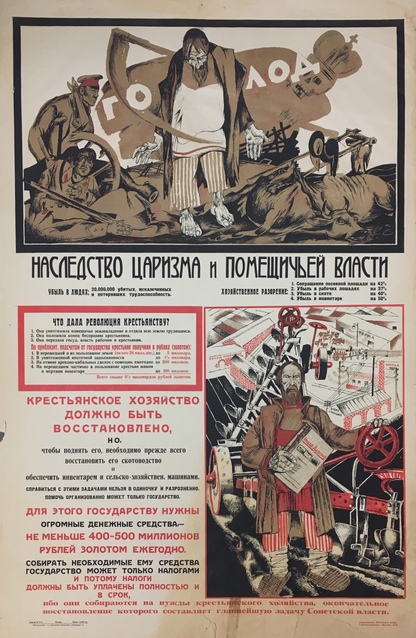Коллекция
Specification:
| Cat. no: | 511 |
| Artist: | |
| Year: | 1923 |
| Issue: | 15 000 |
| Publisher: | Krasnaya Nov |
| Place of publishing: |
|
| Style: |
|
| Printing Technique: | Three colour lithography |
| Language: |
|
| Size: | 107 х 71 |
| Condition: | Satisfactory. A big stain from the impact of time at the bottom. Stains from moisture and a trace of glue in the top part. Tears on the bottom and left edges. |
| Notes: | "Mospoligraf" 1st Еxemplary Printing House Pyatnitskaya, 71 |
| Description: | Loss in people; 20,000,000 people killed, disabled and disabled. Economic ruin 1. Reduction of the sowing area by 42% 2. The loss in workhorses by 37% 3. The loss in livestock by 40% 4. The loss in inventory by 50% What did the revolution give the peasantry? 1. She destroyed the landed estates and gave all the land to the working people. 2. She put an end to the lack of rights of the peasant. 3. She handed over the state. power to the workers and peasants. According to rough estimates from the state, the peasants were taught in rubles (in gold): 1. In the land transferred to their use (about 28 million dessiatins) to 5 billion. 2. In the destroyed mortgage debt up to 1 1/4 billion. 3. On the abolition of rent-bonded transactions with the landowners annually up to 200 million. 4. On the partially transferred to the use of the peasants diva and dead implements to 310 million. Total over 6 1/2 billion rubles in gold. Peasant farming should be restored, but in order to raise it, it is first of all necessary to restore its livestock farming and provide with inventory and agricultural machinery. Cope with these tasks can not be done alone and in isolation. Only the state can help in an organized way. For this, the state needs huge funds - at least 400-500 million rubles in gold annually. The state can collect only the taxes necessary for it, and therefore the taxes must be paid in full and on time, for they are collected for the needs of the peasant economy, the final restoration of which is the chief task of the Soviet government. |
| Period: | 1922-1930 |
| Categories: |
|
| Reference Price: | £ 1600 |


